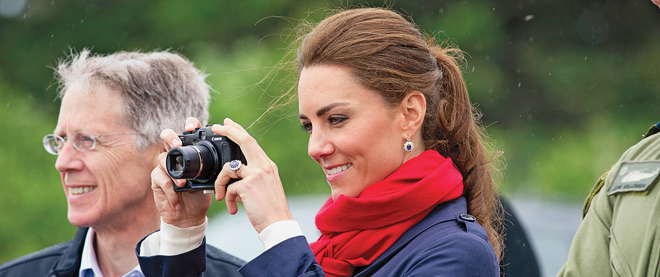We showed them, and the world, a wonderful time
A letter from the editors
Baz Ratner/Reuters
Share

They just might be the most redundant pictures ever taken. While the national and international media lavished attention on Prince William as he repeatedly practised a water landing in a Canadian Forces Sea King helicopter in Prince Edward Island this week, his wife, Catherine, insisted on snapping some pictures of her own.
Getting a few shots for the family scrapbook is the sort of thing a young couple might do on holiday. But during an official state visit it seems delightfully out of place. All of which suggests a royal tour—and a royal couple—that’s refreshingly different and new.
The event at Dalvay by the Sea this past Monday saw William, the duke of Cambridge instructed in “waterbirding,” a unique Canadian emergency technique in which a helicopter pilot lands on water during an engine failure. Prince William specifically requested this personal tutorial, given that he flies helicopters at his day job as a Royal Air Force search and rescue pilot based in Anglesey, Wales.
The training ride generated instant reportage around the world: from the Times of India to ABC News to Internet gossip sites, as well as detailed coverage from nearly every Canadian media outlet. The fact that Kate insisted on taking her own photos of the moment—using what appeared to be a rather run-of-the-mill digital camera—is just one of many aspects of the trip that appears to be a departure from previous royal visits.
Royal tours typically involve the host country putting on demonstrations of national pride during which guests are required to appear dutifully impressed. Surely that was the point behind much of Queen Elizabeth II’s visit last year, which included the usual cornerstone laying ceremonies as well as a trip to Research in Motion’s BlackBerry facilities in Waterloo, Ont. Are these the sort of events an octogenarian monarch would pick on her own?
The 2011 royal tour of the duke and duchess of Cambridge began in much the same fashion, with a stop at the National War Memorial in Ottawa for a wreath laying. But the rest of the tour has largely focused on the young couple’s obvious sense of fun and curiosity. Besides the helicopter instruction and a lighthearted dragon boat race in P.E.I., the tour has included such diversions as a cooking class in Montreal and a street hockey game in Yellowknife. And there have been moments when William and Kate were allowed to simply be a young married couple, as when Prime Minister Stephen Harper arranged for the royal pair to spend a few hours alone at his private retreat at Harrington Lake, where they enjoyed a “love boat picnic,” as one British tabloid described their private time away from prying eyes.
Canadians are often uncertain about how the world will view us. We needn’t be. As last year’s Vancouver Winter Olympics proved, and this royal tour is now proving, Canadians are world-class hosts.
The genuine enthusiasm William and Kate have shown for their Canadian activities has been reflected back in coverage of their visit. ABC News described the Canadian royal tour as “very, very, very successful.” British coverage has been equally effusive. “A love story” is how the BBC website described it. The Guardian said the couple has been met with “frenzied adulation by large crowds.” Even the normally acerbic comedian Joan Rivers seemed to sense the warmth when she tweeted: “Will and Kate are in Canada. Kate used to have a summer home, now she has a summer country.”
In many ways, this attention speaks to the new sensibilities of William and Kate as a royal couple. Despite the apparent inevitability that they will one day reign over the Commonwealth, the young couple’s life together is largely recognizable to the average person: they met in college, broke up, got back together, got engaged while on vacation and had a big wedding.
They provide a new and modern take on tradition that is perfectly calibrated to maintain interest in the monarchy. That they chose Canada for their first international tour underlines this fact for Canadians. Recall that Queen Elizabeth has visited here 23 times, more than any other country.
Perhaps many years in the future a certain king and queen will find themselves flipping through an old family photo album. And they’ll come across pictures they once snapped at Dalvay by the Sea. They will look at each other and say, “Remember that? We had a great time in Canada.” It’s a moment all Canadians should anticipate with pride.